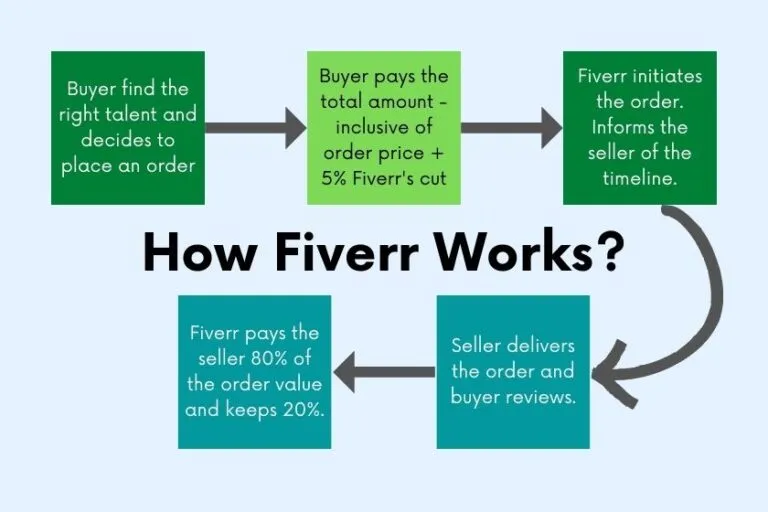Fiverr is a popular online marketplace that connects freelancers with clients who need various digital services. Launched in 2010, it has become a go-to platform for businesses and individuals looking to hire talented professionals for everything from graphic design to programming and writing. The importance of Fiverr lies in its ability to democratize access to skilled labor, allowing anyone with an idea or project to find the right talent at an affordable price.
The platform operates on a unique model where freelancers, referred to as "sellers," can offer their services—also known as "gigs"—starting at just $5. This pricing model has attracted millions of users worldwide, fostering a vibrant community of creatives. For buyers, this means access to a vast pool of expertise without the need for long-term commitments. For sellers, it provides an opportunity to showcase their skills and build a portfolio, all while earning money on their terms.
In an ever-evolving gig economy, understanding how Fiverr operates, especially regarding its algorithm, is crucial for both buyers and sellers. The Fiverr algorithm plays a significant role in determining how gigs are ranked, which affects visibility and earnings. In this blog post, we’ll demystify the Fiverr algorithm and explore how it impacts your experience on the platform.
Understanding Algorithms: What They Are and How They Function

Before diving deeper into the Fiverr algorithm specifically, it’s essential to grasp the concept of algorithms in general. Simply put, an algorithm is a set of rules or calculations used to solve problems or process data. They are integral to various technologies we use today, from social media feeds to search engines, helping determine what information is displayed to users based on their behavior and preferences.
In the context of platforms like Fiverr, algorithms work to match buyers with the most suitable sellers based on multiple factors. *Understanding how these algorithms function can give you a competitive edge. Here’s a closer look at their basic components:*
- Data Input: Algorithms rely on data input, such as user behavior, engagement, and preferences. For Fiverr, this could include how often a seller’s gig is viewed, how many orders they receive, and customer reviews.
- Ranking Signals: These are key performance indicators that the algorithm uses to evaluate the quality and relevance of gigs. On Fiverr, ranking signals might include gig title, description, tags, and seller response time.
- Machine Learning: Many modern algorithms employ machine learning techniques to improve their performance over time. The Fiverr algorithm adapts based on patterns it detects in buyer behavior.
In simple terms, algorithms are designed to enhance user experience by surfacing the most relevant and high-quality content based on specific criteria. Understanding these intricacies can be incredibly beneficial for freelancers looking to optimize their gigs for better visibility.
Also Read This: How to Transfer Fiverr Earnings: A Step-by-Step Guide
The Key Components of the Fiverr Algorithm

The Fiverr algorithm is a complex system designed to connect freelancers with clients effectively. Understanding its key components can help both parties make the most of their experience on the platform. Here are the primary elements:
- Relevance: The algorithm assesses the relevance of a gig by analyzing keywords in both titles and descriptions. Including the right keywords ensures that the gig appears in relevant search results.
- Reviews and Ratings: Freelancers can't underestimate the power of reviews. Gigs with higher ratings and positive feedback tend to rank higher in searches, as the algorithm perceives them as more trustworthy.
- Order Completion Rate: This refers to the percentage of orders that freelancers successfully complete. A higher completion rate signals reliability, boosting the gig's visibility.
- Response Time: Quick responses to client inquiries not only improve user experience but also enhance rankings. The algorithm favors active freelancers who engage promptly.
- Seller Level: Fiverr has different seller levels (New Seller, Level One, Level Two, and Top Rated Seller). As freelancers gain experience and meet specific criteria, they can advance in levels, increasing their visibility and attracting more clients.
- Gig Performance: Metrics such as impressions, clicks, and conversion rates directly impact how well a gig performs. The algorithm continuously evaluates these metrics to determine which gigs to promote.
Grasping these key components gives both freelancers and clients a clearer picture of how they can optimize their presence on the platform and ultimately achieve their goals.
Also Read This: How to Make Money on Fiverr Affiliate
How the Algorithm Affects Freelancers and Clients

The Fiverr algorithm plays a crucial role in shaping the experience of both freelancers and clients, impacting how they interact with each other on the platform. Here’s how:
- Visibility for Freelancers: For freelancers, a well-optimized gig can mean the difference between landing numerous projects and being overlooked. A gig that aligns with the algorithm's preferences is more likely to appear at the top of search results, increasing the chances of receiving orders.
- Equal Opportunity: New sellers might feel at a disadvantage initially, but the algorithm offers equal opportunity to everyone. With the right strategies—like maintaining high-quality work, soliciting reviews, and optimizing gig descriptions—new freelancers can gain visibility quickly.
- Client Experience: For clients, the algorithm helps surface the best freelancers for their needs. By displaying higher-rated gigs and trusted sellers, clients can reduce the time spent searching for suitable candidates, leading to a smoother and more efficient hiring process.
- Competitive Edge: Freelancers who understand and adapt to the algorithm can maintain a competitive edge. Regularly refreshing gig content, updating portfolio pieces, and even adjusting pricing strategies in line with market demand can enhance visibility.
- Feedback Loop: The algorithm creates a feedback loop for freelancers. Positive client interactions help gigs rank better, which then attracts more clients, solidifying a freelancer’s reputation on the platform.
In essence, the Fiverr algorithm serves to connect the dots between freelancers and clients by ensuring that the right talent meets the right project needs, ultimately enriching the community as a whole.
Also Read This: What is the Best Music Promotion on Fiverr?
Tips for Sellers to Improve Their Rankings
Improving your Fiverr rankings can feel a bit like climbing an uphill mountain—daunting at first but totally achievable with the right strategies. Here are some tips that can boost your visibility and help you sell more effectively:
- Optimize Your Gig Title and Description: Use relevant keywords that potential buyers are likely to search for. Make your gig title engaging yet descriptive to capture attention.
- High-Quality Images and Videos: Visuals matter! Invest time in creating eye-catching thumbnails and professional videos. Remember, a picture is worth a thousand words.
- Competitive Pricing: Offer fair prices that reflect the quality of your work. An introductory offer can also attract initial sales, setting you up for future success.
- Fast Response Times: Aim to respond to inquiries as quickly as possible. Fiverr values sellers who are attentive and quick to engage.
- Encourage Positive Reviews: Always strive to deliver top-grade service. Remind satisfied customers to leave a review. Good ratings can significantly boost your ranking.
- Active Promotion: Share your gigs on social media and through other channels. The more people see and engage with your gigs, the better your chances of climbing the algorithm.
Implementing these strategies consistently can help elevate your Fiverr profile, attract new clients, and ultimately lead to more sales!
Also Read This: How to Get Impressions on Fiverr
Common Misconceptions About the Fiverr Algorithm
When it comes to the Fiverr algorithm, there are a lot of myths out there that can leave sellers feeling confused. Let’s clear up some common misconceptions:
- Myth 1: The Algorithm is Random: Contrary to popular belief, the Fiverr algorithm is based on various metrics, not random chance. Factors like performance, reviews, and delivery time all play a significant role.
- Myth 2: Only Top Sellers Get Noticed: While top-rated sellers do enjoy benefits like heightened visibility, new sellers can succeed too! With the right tactics and dedication, anyone can rise through the ranks.
- Myth 3: Once You Create a Gig, You're Set: This is a big misconception! Regularly updating your gigs, experimenting with new techniques, and responding to client feedback are crucial for sustained performance.
- Myth 4: Fiverr Promotes Only Certain Categories: Fiverr's algorithm aims to provide the best matches for buyers, meaning all categories can flourish if the sellers put in the effort.
- Myth 5: Negative Reviews Destroy Your Profile: While bad reviews can impact your ranking, one or two won’t spell doom. You can recover from them by consistently delivering excellent service and gathering positive feedback.
By understanding these misconceptions, you can focus on strategies that truly matter and navigate the Fiverr platform more effectively.
How Does the Fiverr Algorithm Work?
Understanding the Fiverr algorithm is crucial for freelancers looking to enhance their visibility and attractiveness on the platform. The algorithm is designed to match buyers with the most relevant services based on a variety of factors. Here’s a detailed breakdown of how it works:
Key Factors Influencing the Algorithm
- Gig Quality: High-quality gigs with comprehensive descriptions, relevant tags, and appealing visuals rank better.
- Buyer Engagement: Metrics such as click-through rates, orders, and reviews reflect a gig’s popularity and help improve its ranking.
- Response Rate: Sellers who respond promptly to inquiries are favored, showcasing reliability and professionalism.
- Order Completion Rate: Successfully completing orders enhances credibility and favors sellers in the algorithm.
- Profile Strength: A complete and well-optimized profile contributes significantly to algorithm evaluation.
Additional Considerations
Beyond the primary factors, the Fiverr algorithm also takes into account:
- Keyword Optimization: Utilizing relevant keywords strategically in your gig title and description can enhance searchability.
- Pricing: Competitive pricing may attract more buyers and increase gig visibility.
- Promotions: Actively promoting gigs through social media or Fiverr’s internal promotions can improve visibility.
Fiverr Ranking Table
| Ranking Factor | Impact Level |
|---|---|
| Gig Quality | High |
| Buyer Engagement | High |
| Response Rate | Medium |
| Order Completion Rate | High |
| Profile Strength | Medium |
In summary, understanding and leveraging the Fiverr algorithm's intricacies can significantly impact your success on the platform. By optimizing your gigs and maintaining a strong seller profile, you can improve your chances of ranking higher and attracting more clients.
Conclusion: Staying Ahead in the Fiverr Marketplace
To thrive in the Fiverr marketplace, continuously adapt your strategies to align with the evolving algorithm, focusing on quality, engagement, and consistency.



